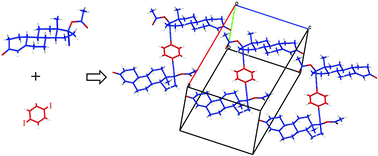Synthesis and solid state characterization of molecular rotors with steroidal stators: ethisterone and norethisterone†
Abstract
In this article we describe the synthesis and dynamic behavior of two new molecular rotors with

* Corresponding authors
a
Departamento de Química, Centro de Investigación y de Estudios Avanzados del IPN, Apartado postal 14-740, México, México
E-mail:
rsantill@cinvestav.mx
b Facultad de Química, Departamento de Química Orgánica, Universidad Nacional Autónoma de México, Ciudad Universitaria, México, México
c
Chemistry and Biochemistry Department, University of California, Los Angeles, USA
E-mail:
mgg@chem.ucla.edu
In this article we describe the synthesis and dynamic behavior of two new molecular rotors with

 Please wait while we load your content...
Something went wrong. Try again?
Please wait while we load your content...
Something went wrong. Try again?
B. Rodríguez-Molina, A. Pozos, R. Cruz, M. Romero, B. Flores, N. Farfán, R. Santillan and M. A. Garcia-Garibay, Org. Biomol. Chem., 2010, 8, 2993 DOI: 10.1039/C003778H
To request permission to reproduce material from this article, please go to the Copyright Clearance Center request page.
If you are an author contributing to an RSC publication, you do not need to request permission provided correct acknowledgement is given.
If you are the author of this article, you do not need to request permission to reproduce figures and diagrams provided correct acknowledgement is given. If you want to reproduce the whole article in a third-party publication (excluding your thesis/dissertation for which permission is not required) please go to the Copyright Clearance Center request page.
Read more about how to correctly acknowledge RSC content.
 Fetching data from CrossRef.
Fetching data from CrossRef.
This may take some time to load.
Loading related content
